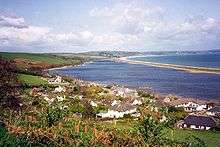Slapton Ley

Slapton Ley is a lake on the south coast of Devon, England, separated from Start Bay by a shingle beach, known as Slapton Sands.
Slapton Ley is the largest natural freshwater lake in south-west England being 1.5 miles (2.4 km) long and has two sections; the Lower Ley and the Higher Ley.[1][2] The ley is fed by streams and a small river, The Gara, that flows into the Higher Ley. The site is a National Nature Reserve, a Site of Special Scientific Interest and a Geological Conservation Review site.[3] The nature reserve covers over 200 hectares (490 acres).[4][2]
The A379 between the Ley and the sea runs along the shingle ridge and was rebuilt after damage by coastal erosion in the early 2000s.[4]
Ecology and wildlife
The Slapton Ley nature reserve is owned by the Whitley Wildlife Conservation Trust and managed by the Field Studies Council.[4][5] Slapton Ley’s beaches are affected by erosion but the beaches are formed from sediment; this makes them special because they are non-replaceable: once the sediment is moved it is gone. The beach can only become smaller. This threatens the security of the mainland because when the beaches are gone, mass amounts of water damage would occur on the land. The nature reserve would be destroyed and the site of special scientific interest would be lost.[6]
There is a large population of Cetti's warbler (Cettia cetti) at the site,[4] and Eurasian bittern (Botaurus stellaris) are resident. Slapton Ley is the only UK site for strapwort (Corrigiola litoralis), a plant identified by Natural England as being at high risk of going extinct by 2020.[7] Seed taken from the site, and grown at Paignton Zoo are due to be planted at Loe Pool, Cornwall in May 2015; where it has not been recorded since 1915.[8][9][10]
References
- ↑ "Slapton Ley". Field Studies Council. Retrieved 14 August 2016.
- 1 2 "Slapton Ley". Devon Birds. Retrieved 14 August 2016.
- ↑ May, V J; Hansom, J D (2003). Coastal Geomorphology of Great Britain - Slapton Sands. Peterborough: JNCC. Retrieved 27 March 2015.
- 1 2 3 4 "Slapton Ley - a wildlife wonder". BBC. Retrieved 14 August 2016.
- ↑ "Devon's National Nature Reserves". Natural England. Retrieved 14 August 2016.
- ↑ Morey, C.R. (1976). "The Natuiral History of Slapton Ley Nature Reserve. IX: The Morphology and History of the Lake Basins" (PDF). Field Studies Journal. 4: 353–368.
- ↑ "Strapwort". Whiteley Wildlife Conservation Trust. Retrieved 14 August 2016.
- ↑ Graeme (26 March 2015). "Bid to save extremely rare plant strapwort at Loe Pool Helston by National Trust". West Briton. Retrieved 27 March 2015.
- ↑ Bennallick, Ian J; French, Colin N; Parslow, Rosemary E (2009). Vascular Plants. In CISFBR Red Data Book for Cornwall and the Isles of Scilly (2nd ed.). Praze-an-Beeble: Croceago Press. pp. 105–157. ISBN 9781901685015.
- ↑ "Strapwort". Slapton Ley. Field Studies Council.
Coordinates: 50°16′59″N 3°39′11″W / 50.283°N 3.653°W